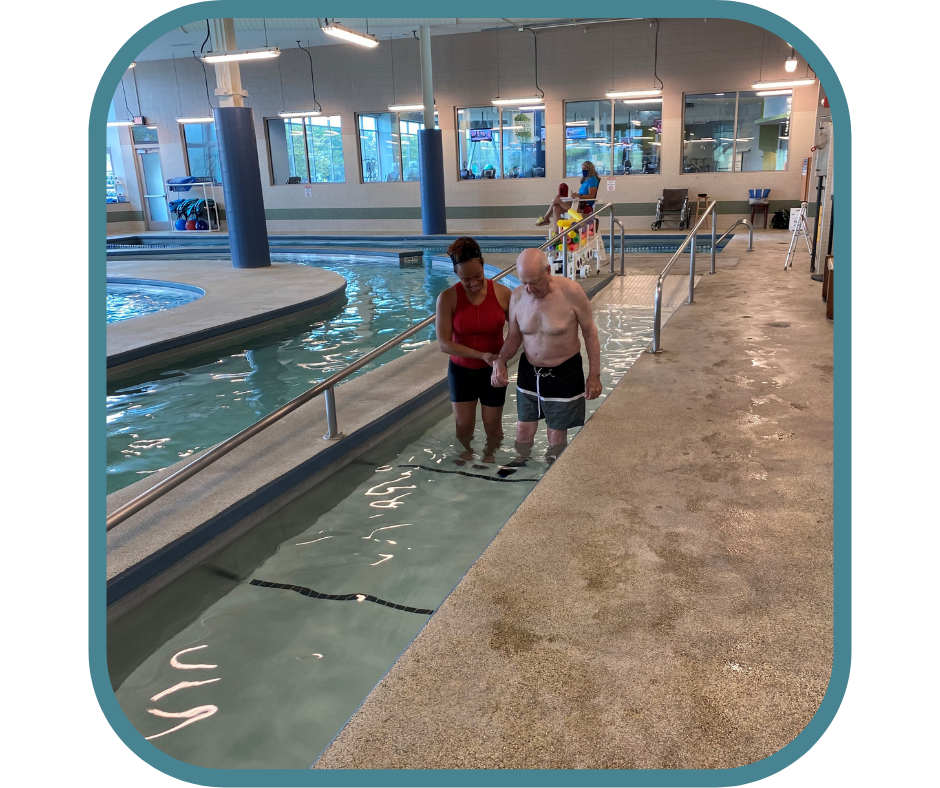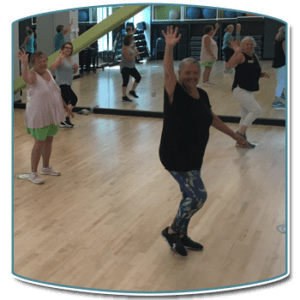An individual’s overall health and commitment to rehabilitation, plus use of support resources, time and other factors, all play a role in guiding a return to an active lifestyle after suffering a debilitating health challenge. In this spotlight, PWC members Rick and Karen share Rick’s rehabilitation experience after he suffered a stroke in March 2020.
As a first step in his recovery, Rick pursued extensive physical therapy with Culpeper Medical Center Physical Therapy and Rehabilitation Services, located at PWC. In fall 2020 Rick and Karen felt ready to stay active on their own and they decided to become PWC members.
Initially, Rick exercised on the NuStep recumbent cross trainer, but Karen remembers that he always had his eye on the pool. She recalls, “The thought was overwhelming that he could ever get into the pool. I was worried about needing to get Rick into the water with a chair lift and using a wheelchair around the pool… you name it, I worried and so did Rick.”
During one of their visits to PWC, Rick and Karen happened to see personal trainer Heather Boggess working with a client. “We could tell that she was good at working with someone who was suffering from a debilitating problem,” says Karen. The couple followed up and contacted Heather.
Heather says, “Once we sat down to discuss some of Rick’s goals, I suggested the pool as a place to start. He wanted to strengthen his right side more as that was the side affected by the stroke. I explained the benefits of water training and Rick and Karen were immediately on board. The water gives people more confidence and it’s a safe place to regain more function due to being surrounded by resistance.”
The main training goal for Rick was to build confidence in using the right side of his body. Karen observes, “His leg improvement has been amazing and we are hoping to work more on his right hand. Rick would still like to be able to use his right hand to eat and write but this is a big challenge since some of the challenges (rotator cuff problems) are unrelated to the stroke.”
In their sessions, Rick and Heather constantly practice making the connection that his brain still communicates to his right side. Heather says, “We complete various drills; for instance, one where Rick aims to bring his knee to a certain area and balance without losing control on his right side. After more than 14 sessions together, he is able to walk in the water independently, and has progressed to walking more independently on land as we exit the pool.”

“We can’t believe all the positives that have come out of the work with Heather,” says Karen. She and Rick highlight the following:
- A big mental boost – recognition that it is possible to have some fun in life again
- Balance developed for walking unassisted in the water
- Using steps to get into and out of water has become a regular practice
- Range of motion activity with both arms has become easier
- Training right hand to grasp pool bar has become natural
- Walking forward and backward in water achieved
- Walking the ramp into the pool
- Understanding commands for left leg versus right leg
- Improvements in speech as a result of talking things through slowly
Reflecting on the role of personal training in Rick’s recovery, Karen notes that it is hard to put into words. “There was a subtle build up in learning to trust Heather,” she says, adding, “You can’t go forward if you’re not bonding with your trainer. Heather’s dad had a hemorrhagic stroke and this went a long way towards helping Rick trust her and know that she wouldn’t see him as hopeless. She also shares a certain sense of humor with Rick – they are on the same channel, so to speak.”
Another important component of Rick’s recovery effort was the coordination between his personal training experience with Heather and the physical therapists who had worked with him earlier. Karen says, “There was good interaction with Daniel McEwen and Stacy Keser, the physical therapists of Culpeper Medical Center’s rehabilitation center at PWC. They were instrumental in getting information to Heather for his shoulder exercises in the water.”
The integration of physical therapy and personal training for recovery is important. Heather explains, “Physical therapy is to get you functioning again, and personal training will build upon that foundation to make it firmer, and then progress to strengthening. The two work hand in hand.”
Hand in hand also describes the partnership between Karen and Rick in support of his recovery. Heather says, “Rick wants to improve and Karen supports him and continues the exercises at home that were received in PT. Once Karen and Rick feel they’ve mastered one area, we add another step to move toward Rick’s next goal.”
Thank you to Rick and Karen for sharing Rick’s recovery journey.

